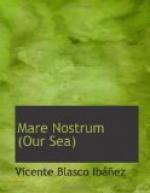Every oceanic creature is able to extract from the water the residuum from certain metals dissolved into particles so incalculably tiny that no chemical process could ever capture them. The carbonates of lime deposited by the rivers or dragged from the coast serve innumerable species for the construction of their coverings, skeletons, and spiral shells. The corals, filtering the water across their flabby and mucous bodies, solidify their hard skeletons so that they may finally be converted into habitable islands.
The beings of disconcerting diversity that were floating, diving, or wiggling around Ferragut were no more than oceanic water. The fish were water made into flesh; the slimy, mucilaginous animals were water in a gelatinous state; the crustaceans and the polypi were water turned to stone.
In one of the tanks he saw a landscape which appeared like that of another planet, grandiose yet at the same time reduced, like a woods seen in a diorama. It was a palm grove, surging up between the rocks, but the rocks were only pebbles, and the palm trees,—annelides of the sea,—were simply worms holding themselves in upright immovability.
They kept their ringed bodies within a leathern tube that formed their protective case, and from this rectilinear, marble-colored trunk sent forth, like a spout of branches, the constantly moving tentacles which served them as organs for breathing and eating.
Endowed with rare sensitiveness, it was enough for a cloud to pass before the sun to make them shrink quickly within these tubes, deprived of their showy capitals, like beheaded palm trees. Then, slowly and prudently the animated pincers would come protruding again through the opening of their cylindrical scabbards, floating in the water with anxious hope. All these trees and flower-animals developed a mechanical voracity whenever a microscopic victim fell under the power of their tentacles; then the soft clusters of branches would contract, close, drawing in their prey, and the worm, withdrawing into the lowest part of the slender tower secreted by himself, would digest his conquest.
The other tanks then attracted the attention of the sailor.
Slipping over the stones, introducing themselves into their caverns, drowsing, half buried in the sand,—all the varied and tumultuous species of crustaceans were moving their cutting and tentacular grinders and making their Japanese armor gleam: some of their frames were red—almost black—as though guarding the dry blood of a remote combat; others were of a scarlet freshness as though reflecting the first fires of the flaming dawn.




